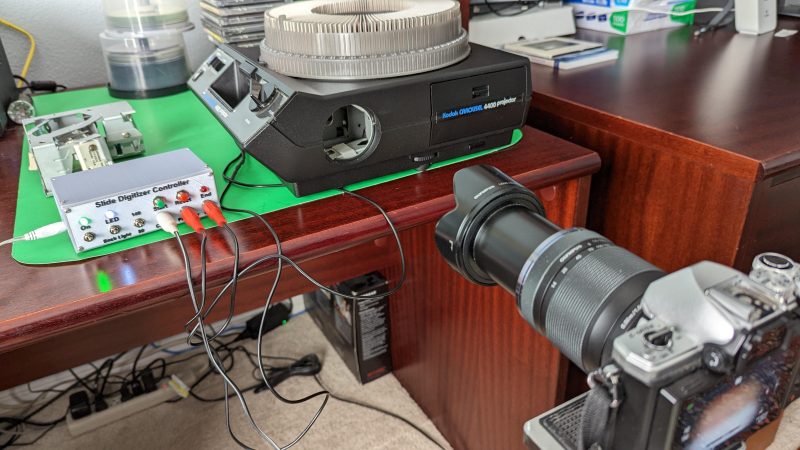Slides make for great old-timey fun, but it’s awesome to have a digital backup of your old photos, too. An automatic digitizer can make quick work of your collection, and this build from [rbwood53] will do just that.
The digitizizer is based on a Kodak carousel slide projector. It’s fitted with LED strips instead of the original light source, which are used to illuminate the slides themselves. An Arduino Nano is used to command a camera to take photos, via a hacked-up shutter release remote. The camera is set up with a zoom lens and relies on auto-focus to get crisp, clear images of the slides. The Arduino is also charged with telling the carousel system to advance to the next slide as required. It keeps count as the slides go by, so it stops when the entire carousel has been imaged.
Overall, it’s a straightforward build that automatically imaged over 40 boxes of slides for [rbwood53] without issue. If you’ve got a smaller collection to digitize, you might find this simple 3D-printed adapter to be useful, too!

















Message in a bottle: if someone knows a flat bed scanner large enough to digitize vinyl record cover (and let’s be crazy even gatefold ones) I am interrested. I dont want these sort of “overhead cameras” but really a flatbed scanner behemoth
I built a similar setup but never bothered to fully automate it. Getting a good image required non reversible modifications to the projector lens mount. These projectors are very common so I didn’t mind permenantly modifying it.
For the backlight I used a high CRI LED and acrylic diffuser from https://www.cameradactyl.com/
A good quality macro lens is essential as normal lenses do not have a planar field of focus resulting in a lack of sharpness around the edges when focusing on something close up. The original focusing system had to be removed and the body opened up to get the lens in close enough to avoid a large crop.
I had planned on fully automating this but I found that it required a lot of supervision as many slides were portraits and often they failed to feed reliably. I don’t think fully automating it would have saved me much time in the long run. When it works perfectly the time taken to do a full 140 carrousel is measured in minutes rather than hours.
High CRI is critical with a project like this. The ~$10 strips they used dont look to be of high quality.
High CRI LED white diffuser and using the existing optics to get an even flat backlight is important.
One of the biggest issues I ran into was specs of dust on the diffuser. It can be hard to notice at first but is really obvious when you see the same dust on repeated images. Use a wide open aperture and you get aberrations use to small of an aperture and you can see the dust on the diffuser.
Sticking 20-30 slides on a flat bed scanner can make short work of this as well. Then you cut the slide images apart in PhotoShop. Bingo, all those old slides are now digitized.
but at what resolution?
6400 dpi
DSLR scanning like this is way faster than flatbed scanners.
And if your slides are in carrousels it avoids having to handle the individual slides.
This is pretty neat from a time-used perspective, but I think I prefer the results from a scanner with a backlit lid and Digital ICE (on it scans in visible light, and then again in IR, and subtracts the IR picture to remove dust and scratches).
Now, if we could just figure out a way to cram an entire box of slides through one of those without me having to touch anything, I’d be set.
I have the same need. I was using a Nikon Coolscan negative/film scanner (with ICE) to scan the thousands of Kodachrome and b/w slides and negs my dad took from the 1950s through the 1990s. I don’t have the motorised slide magazine unit though, and that’s why I’ve only done a few hundred so far :(
Kind of a hard work just for a digital image. Just shoot with digital camera.
The time travel required to go back and retake your family photos with a modern digital camera is much more difficult than digitizing your families old slide collection.
It also avoids the grandfather paradox.